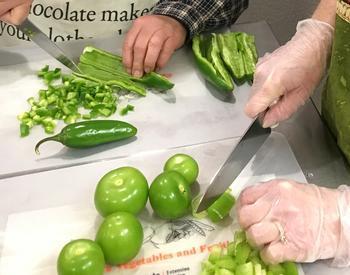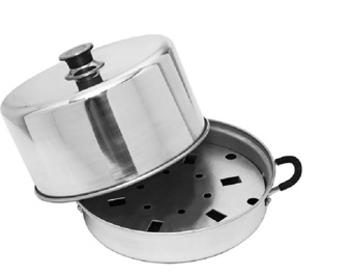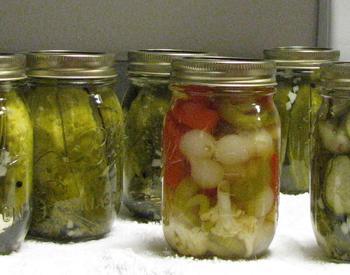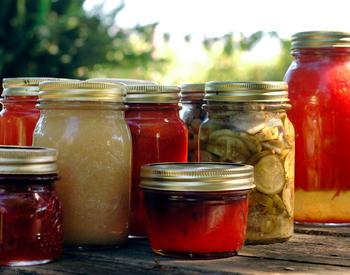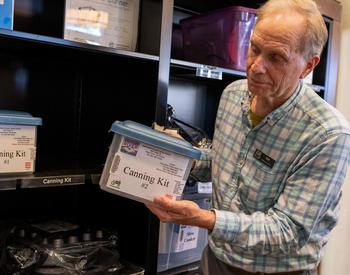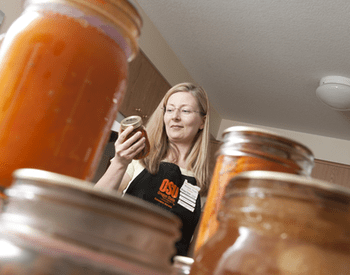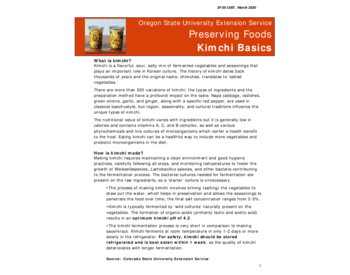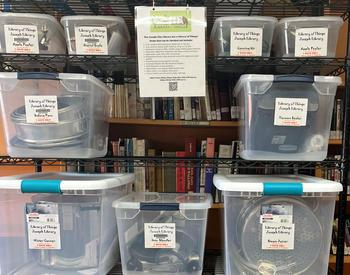Download this publication as a PDF
Preserving juice at home can be easy and economical if the fruit is obtained at low cost. Home-preserved fruit juices can be used as:
- Breakfast beverages.
- Soft drink substitutes.
- Bases for punch.
- Making jelly.
There are two kinds of fruit juices: those that are strained and clear (like grape, berry, and cherry juice); and nectars, which are whole fruit juices usually made from peaches, apricots and pears. The nectars are thickened with fine-sieved pulp.
Store home-canned fruit juices in a dark, cool dry place so the color won't fade or change.
Preparing fruit juice
Select fully ripe fruit for best-flavored juices. A combination of fruit can be used to make interesting flavors.
Prepare fruit by washing, sorting, crushing or grinding. Place the fruit pulp in a large aluminum or stainless steel pan. Note: Aluminum can cause a slight color change.
When heating the pulp, it is important to stir constantly to prevent sticking. If the fruit remains firm, simmer 1 or 2 minutes. Avoid overcooking because it destroys the fresh fruit flavor. Juices should be extracted at simmering temperatures (185–210°F).
Follow one of these methods to extract the juice:
Drip method
Pour hot prepared fruit pulp into a jelly bag or through several layers of cheesecloth. Let drip overnight, if necessary. Do not squeeze the bags.
Steam juicing
One of the easiest ways to extract juice is by using a steam juicer available at many hardware and variety stores. The unique piece of equipment allows you to conveniently extract juice by steaming the fruit that is held in a retaining basket. The juice drops into a reservoir that has a tube outlet for removal. Follow manufacturer's instructions for using steam juicer.
Preserving the juice
To can
Sterilize jars by placing right side up on racks in boiling water canner. Fill the canner and jars with hot (not boiling) water to 1 inch above the tops of the jars. Boil 10 minutes. If juice has cooled, heat to simmering. Pout into hot, sterile jars and process in a boiling water bath: 5 minutes for pint and quarts; 10 minutes for half-gallons.
To freeze
Cool juice into moisture vapor-resistant container. If using glass or plastic jars, leave 2-inch headspace.
Making and preserving apple cider
Sweet apple cider is made from fresh crushed apples. It is not cooked to chemically preserved. When fermented, "hard" cider (an alcoholic beverage) is produced.
Selecting the apples
Select apples that are just ripe for eating. Most ciders are made from a blend of different varieties. Delicious, McIntosh, Rome and Gravensteins are commonly used. Tart apples should be used in small portions; they are a good source of tannic acid that keeps the cider sweet longer, but they also affect the flavor.
Grinding the apples
Wash and rinse the apples before grinding. Grinding is necessary to release the juice from the apples. For small batches, quarter unpeeled apples and run through a kitchen food grinder or chop on a food processor. For large batches, it is faster to rent or borrow a cider mill with crusher attached.
Letting the crushed fruit stand for 30 minutes to an hour will yield more cider from the apples.
Pressing the apples
The cider can be pressed from the crushed apples in a cider press. These presses can be rented, purchased or built at home. Most home presses employ a heavy screw for pressure. Pressure should be applied slowly and evenly. Fresh-pressed cider has a cloudy appearance. It should be strained through a clean cloth as it drips from the press into the reservoir pan.
A homemade press for small patches can be made using a strong jelly bag and a rolling pin. The bag should be pressed slowly and steadily to avoid bursting the bag. The process requires more strength and is very slow for large batches. The bag can also be squeezed by hand. Be careful not to break the bag.
Pasteurizing the juice
Unpasteurized (unheated) apple cider has been linked to illness caused by E.coli O157:H7 bacteria. If these bacteria are in the feces of deer or cattle, apples that fall on the ground could be contaminated.
Pasteurization kills harmful bacteria. Heat the juice to at least 160°F. If you don't have a thermometer that registers in the range, heat the juice until it simmers (when bubbles appear on the surface).
Preserving the juice
Pasteurized cider can be stored in the refrigerator for about a week. For longer storage, freezing is recommended. When freezing, be sure to allow at least a 2-inch headspace since the cider will expand during freezing and can rupture the container.
Apple juice may also be canned. Heat the juice to simmering (185–210°F). Pour hot juice into hot, sterilized jars. Process in a boiling water canner: 5 minutes for pints and quarts; 10 minutes for half-gallons. At 1,001–6,000 feet, process pints and quarts for 10 minutes and half-gallons for 15 minutes. After processing, take canner off heat. Remove lid and wait 5 minutes before removing jars.
For additional information on making juices or cider, contact your local country Extension office.
Related articles:



